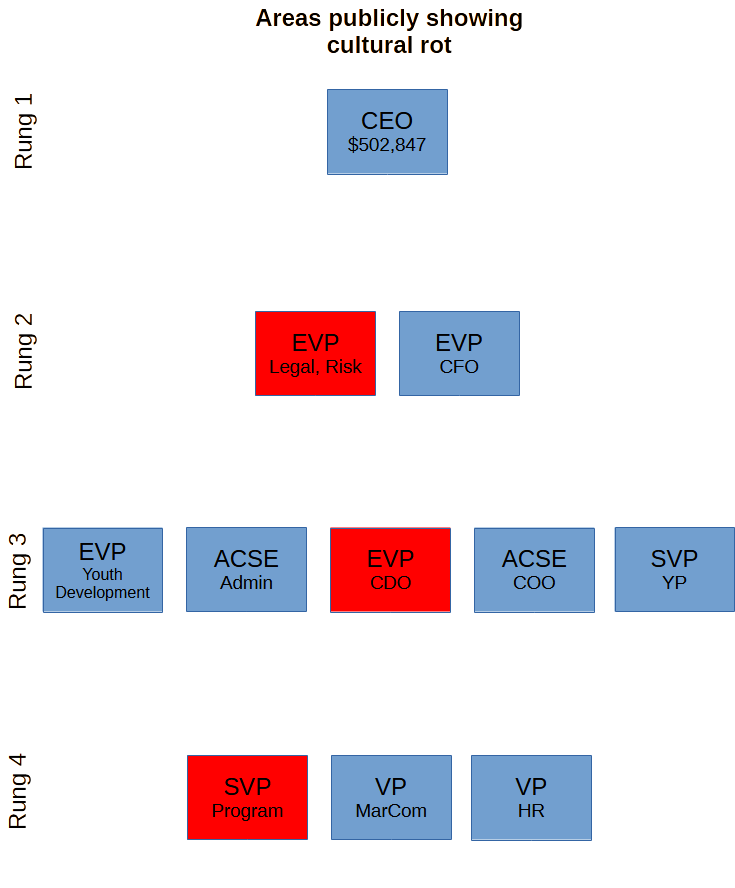Summary
BSA’s national office just restructured. The changes were described as “strategic reassignments” to address “immediate and long-term needs”.
These changes send two messages:
- BSA is betting the farm on raw revenue production and raw asset protection.
- The least important concerns are now the unit program–the very thing that makes BSA distinct–and getting new members. I’ll explain more later, but throwing marketing to the bottom is why I wrote “raw revenue production”. This reveals that the revenue-production focus is on measures other than membership growth.
By betting the farm on bureaucrats and casting to the bottom what makes us distinct, BSA signals that its national office may be in a death spiral.
About as bad: The national office has deep cultural rot thanks to factors like an obsolete career system, pervasive throwback-reactionary culture, a mindset of bureaucratic bloat, and immense debt obligations. Instead of excising the rot, the new model reinforces it, even uplifting a prolific source of rot.
This is a defensive, circle-the-wagons move. It is not a bold vision of a viable BSA. Is it time to replace the national office and start over?
Winners and losers
In terms of CEO attention, we have winners and losers:
| Winners (more CEO attention) | Losers (less CEO attention) |
|
|
BSA’s old and new models
In the prior organizational model, all the positions on rung 2 were equal, all reporting to the CEO:

Some clarification: CDO is Chief Development Officer. That person leads fundraising. NST is National Service Territory. The two NST VPs nominally divided up duties of BSA’s 16 territories, and they had some other duties:
- NST 9-16’s VP also had unit-level program–Cub Scouts, Scouts BSA, Exploring–and Program Management.
- NST 1-8’s VP also had Council Services.
The new model, where most areas were demoted one or two rungs:

In the new model, you have an Office of the CEO, which includes the CEO and two direct reports. Everyone else on the old org chart got knocked down to third and fourth rungs. Per BSA’s internal announcement, the third rung reports not to an individual but to this new Office of the CEO.
NOTE: From here on, I use “program” to refer to unit-level program. It is in a group named “Program”. While there are other programs run out of national, like high adventure and camping, they roll up into differently named groups.
Winners list
First, let’s review the winners.
Legal/Risk Management and Finance won: they stayed on their same rungs while all their peers dropped to lower rungs. These areas each get half the CEO’s attention, far improved from an eighth. Also, a humiliating message was sent to five of their former peers: you now report to us two.
BSA is now defined by two bureaucratic functions. Not program. Not growth. But bureaucracy. Now, everything about the national office is filtered through bureaucratic lenses of income and risk.
Does it cause more Scout Shop sales? Does it make insurance more expensive? Does it make current members pay more? Would someone sue us? Does it scrape money together for its money-losing, Scouting-themed amusement park’s The Summit’s enormous debt? The new model invites questions like these to lead every last action of the national office.
Youth Protection also “won” but only through a title change. It used to be led an “officer” reporting to the Executive VP (EVP) over legal and risk. Now reporting to the Office of the CEO (more on that in the next section), it’s a Senior VP. It’s still on rung 3, and my guess is the legal/risk EVP will be assigned to supervise this function. This small change is part of how BSA is honoring a provision of the bankruptcy settlement.
Losers list
All other concerns are losers. Instead of reporting to the CEO, four concerns were demoted to the third rung, now reporting to the Office of the CEO along with the Youth Protection SVP.
Yes, that is correct, they report to an office, not to a person! But let’s be real: The point of this change is to keep these five out of the CEO’s hair. All but the Youth Protection SVP are now reporting to a former peer, to the CFO or to the EVP over legal/risk. (Since the YP SVP will certainly report to the legal/risk EVP, that’s no change in reporting for that role.)
While these five areas are losers in the reorganization, their executive leads got a minor win. A person reporting to a committee gains less accountability and more power over a kingdom. Given the national office’s rotted culture, I have fox/henhouse concerns.
Two concerns were double-demoted, from rung two to rung four:
- Marketing and Communications
- Program
Additionally, marcom’s lead is now reduced to a VP instead of an EVP. This is not a problem with the person. The former EVP over this concern retired, and a director was promoted to a VP. It remains that both a huge demotion and a title reduction happened to the role of marcom’s lead.
I am surprised program and marcom were deemed that unimportant. Isn’t our program what distinguishes us from other organizations? Isn’t marketing crucial to growing our program?
Strangely, despite being double-demoted, the lead of program got a title increase. This is vague messaging. The title was formerly VP. It’s now Senior VP.
Now here’s a detail that muddies things. The fourth-rung people also have a dotted-line report to the Office of the CEO. I don’t show that on the chart because all it likely means is the program and marcom leads will occasionally prepare reports for the CEO, EVP legal/risk, and CFO, and they will occasionally get to ask questions. It doesn’t change the unambiguous language in BSA’s internal announcement: these two still directly report to third-rung people. Program and marcom used to nominally get 1/8 of the CEO’s focus. Now they get scraps.
Let me pull together some things above to reemphasize a key point. We have two groups that own concerns that define BSA and most directly cause us to grow. Those groups suffered severe, collective blows:
- Dropped two rungs.
- Title reduction for the marcom lead role.
- Report into areas that now have less accountability.
- Report into areas that now have less CEO attention.
Altogether, this is a devastating slap to unit-program and marcom.
To make the effect of the double demotions clear, here’s some other national-office roles on the same rung as the VPs of marcom and program:
- Director of Council Services
- Senior Document Control Specialist
- Director of Tax Accounting
Do you think any of these are as crucial to BSA as program and growth?
Opportunities to correct cultural rot
I want to go into more detail on a few areas: Program, legal/risk management, and development. These areas are responsible for a great deal of the misperformance that, until now, I have characterized as general problems with the national office.

That said, I stand by my general characterization of the national office. It is no better than its premier products. Its premier products are the program itself and the ways it equips volunteer leaders. The development office also has a highly visible function. All these have deep rot.
Program’s rot
First, remember that the old model had two VP roles that split National Service Territories. These roles now have more distinct functions.
One of these VPs got demoted only one rung but got a title boost to Executive VP. I expect that person took on the six territory directors from the other NST VP. The person losing the territory directors got demoted two rungs, is now focused on program, and got a weaker title improvement, from VP to Senior VP.
Now we have a SVP who can focus more on program. This could be a good thing but only if that SVP is willing to expect better from his staff and volunteers.
Here’s the deal: the program SVP owns a national-office function that is overrun with anti-intellectualism and throwback-reactionary culture. That VP’s staff and volunteer committees are behind the epic blunder of the specious coed ban. The Order of the Arrow (OA), which has endemic brownface cosplay, reports into that VP. (To be charitable, I am aware of other dark forces, outside of the SVP Program’s area, that are also preventing OA from improving.)
Also, the SVP Program’s area sat on their hands while Legal/Risk Management eviscerated Cub Scout camping. I can understand wanting to avoid airing dirty laundry, but this staff has been ineffective, for months ignoring legions of bewildered unit leaders who were slammed by the change.
Legal/risk’s rot
And that leads me to Legal/Risk Management. That staff is also associated with cultural rot.
It has a track record of arbitrary and capricious decision-making. By declining to share rationales for the rules it creates, it shows arrogance and declines to equip volunteers for gray areas.
As an example, its recent, ham-fisted evisceration of Cub Scout camping was done in secret. This area has yet to provide a rational justification for this change. This is just par for the course. Transparency and public accountability are crucial concerns of effective groups, and these are clearly not priorities for legal/risk.
This area also delivers poor documentation. It is a large contributor to the national office’s bloated corpus of confusing and contradictory volunteer-facing documents. Their documents are so bad, they cause endless, repetitive questions and confusion across the volunteer landscape.
Development’s rot
Finally, we have Development, with its National Eagle Scout Association, a moribund, do-nothing, bloated clown show. In addition to doing next to nothing, NESA will soon celebrate its eleventh year of hustling families over an expensive who’s who-style yearbook, damaging the brand for little revenue.
Will this help clear the rot?
Legal/Risk’s org-chart promotion conveys how important the CEO believes its function is. I hope that leader uses this as justification to improve performance in its public-facing functions.
The Program’s leader’s title promotion and double-demotion sends mixed messages. I hope this area sees this as an opportunity to double down on improvements and make the case to rise back up.
Other than being demoted with three peers, Development’s standing did not change. No title or role changes were apparent. Development can reclaim the high ground by canceling NESA and folding its brand into an affinity group within BSA Alumni.
Summary
BSA’s dramatic organizational changes invite questions about the national office’s viability.
National would be wise to ditch its history of arrogance and instead be transparent: tell us what motivated this. Why did you anoint selected bureaucratic functions over everything else? Why did you cast to the basement matters related to our core distinction and our growth? What challenge does all this speak to?
Disclaimer, due to national’s extreme secrecy
Part of national’s cultural rot is arrogance: When you wear the gold epaulets, of course your wisdom is so supreme, you have no need to explain yourself to peasants. Hence, transparency must be avoided. (To be clear, many of our national volunteers are great and do not have this ethos. But a bad apple spoils the bunch, and national has way too many rotted apples.)
Among national’s most guarded secrets are the composition and function of its volunteer committees. For example, search Google for “National Cub Scouting Committee”. You’ll get little. All you can do is piece together a loose narrative from information fragments.
It is possible that an interpretation of BSA’s organizational changes could shift if expectations of national’s secret committees recently changed. National is invited to be transparent about its secret committees!
All this notwithstanding, my insider contacts convey that national is mainly staff driven. Most committees are toothless or passive. Not strongly factoring in committees may be the right interpretation.

Leave a Reply